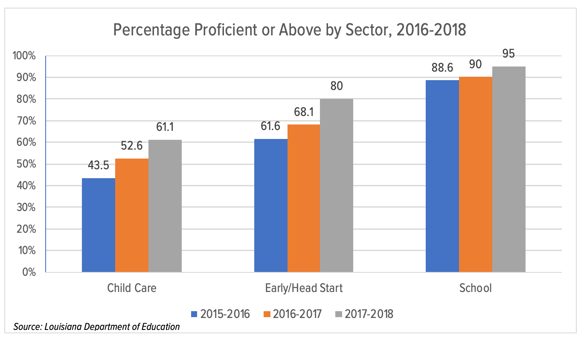
There’s a powerful shift happening in early childhood classrooms across Louisiana. While education leaders across the country have visions of bringing high-quality, impactful interactions to all of their students, leaders in Louisiana have taken deliberate steps to turn their vision into a reality.
Let’s break down those steps a bit.
A New Kind of QRIS
A recent article from EdSurge focuses around the state of Louisiana’s Quality Rating and Improvement System, or QRIS. A QRIS is intended to help define quality early childhood education and care settings, often by assigning a level, number, or star rating. In some states, criteria come from program-level or environmental factors, such as: How many adults are in the room? What are their credentials? What kind of shape is the building in? Some include CLASS or other teacher observation measures in their ratings. Any practitioner knows that all of these things matter, but the more factors there are to keep track of, the harder it is to make meaningful progress on any given one.
Louisiana’s QRIS is unique because it only uses CLASS ratings. This brings the accountability down to the classroom level, and it’s based on something within each teacher’s control. The quality rating is not dictated by the resources a program has but by the choices each teacher makes daily. This allows programs in Louisiana to focus on what matters most.
Another important factor in Louisiana’s QRIS is the coverage. In many states that use CLASS, observations are opt-in, or only for programs at higher accreditation levels, or in alternating years. In contrast, CLASS observations happen in virtually every infant, toddler and pre-K classroom across Louisiana twice each year. This has helped develop a statewide culture of CLASS and provided the state with unparalleled data about the quality of their program.
Taking Local Action
But even with a shared vision, it takes local buy-in to make meaningful change. This has happened by establishing hubs in each parish that manage the observations across all early childhood settings in their area. Pulling these different organizations together at local levels means that decisions can be made for more programs and teachers with more unified data and a shared pool of resources for improvement.
What is the money used for? This is the “I” in QRIS - Improvement. When teachers are observed, they quickly receive feedback on their performance. These conversations are CLASS-specific, which keeps teachers focused on the kinds of interactions that are measured by CLASS and the QRIS and helps them make targeted, manageable goals.
Some teachers are further aided by professional development (PD) funds that can be invested in larger-scale, evidence-based improvement activities, such as MyTeachingPartner (MTP) or CLASS Group Coaching (CGC). These types of high-quality PD are often out of reach for smaller programs, but the local collaboration makes them possible. Parishes throughout Louisiana have built local capacity to provide ongoing support to the teachers who need it most - whether they are in child care, Head Start or state pre-K programs.
Bringing it Home
Lastly, Louisiana has designed its QRIS to include and inform families. The Louisiana School Finder makes CLASS principles and scores visible to families with young children. While the research shows that classroom quality is not the primary factor in parents’ choice of child care, this school finder makes it clear how well a program is doing and what sort of interactions drive that rating. In addition to informing families, it adds another level of accountability to programs, which know that their ratings will be easily accessible.
 Put all of this together and what do you get? Improvement across the system and a shift towards equity. In general, Louisiana’s CLASS scores have increased over the last three years. As the figure shows, much of that improvement has happened in Head Start and childcare settings, which tended to have lower scores than state pre-K programs. What we’re starting to see is some evidence for the closing of the gap between these programs - helping work toward the ambitious goal of letting families choose a program based on convenience and being assured of quality - no matter the setting.
Put all of this together and what do you get? Improvement across the system and a shift towards equity. In general, Louisiana’s CLASS scores have increased over the last three years. As the figure shows, much of that improvement has happened in Head Start and childcare settings, which tended to have lower scores than state pre-K programs. What we’re starting to see is some evidence for the closing of the gap between these programs - helping work toward the ambitious goal of letting families choose a program based on convenience and being assured of quality - no matter the setting.
There is still work to be done. However, by focusing closely on interactions, giving localities the agency to monitor and administer CLASS, and making this information clear and accessible to families, the state of Louisiana has made real strides toward ensuring all young children learn and grow to their fullest potential.
Interested in bringing systematic change to your program? Whether you’re just starting to focus on quality in your program or scaling up your capacity to measure quality and provide professional development, we can help. Schedule a call to learn how you can use CLASS to improve teaching quality in your organization.
